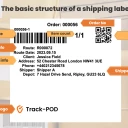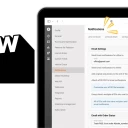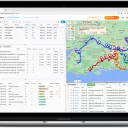Success Strategies for Final Mile Delivery: 2024 Update
Updated on
March 21, 2024
by
Mike Foster
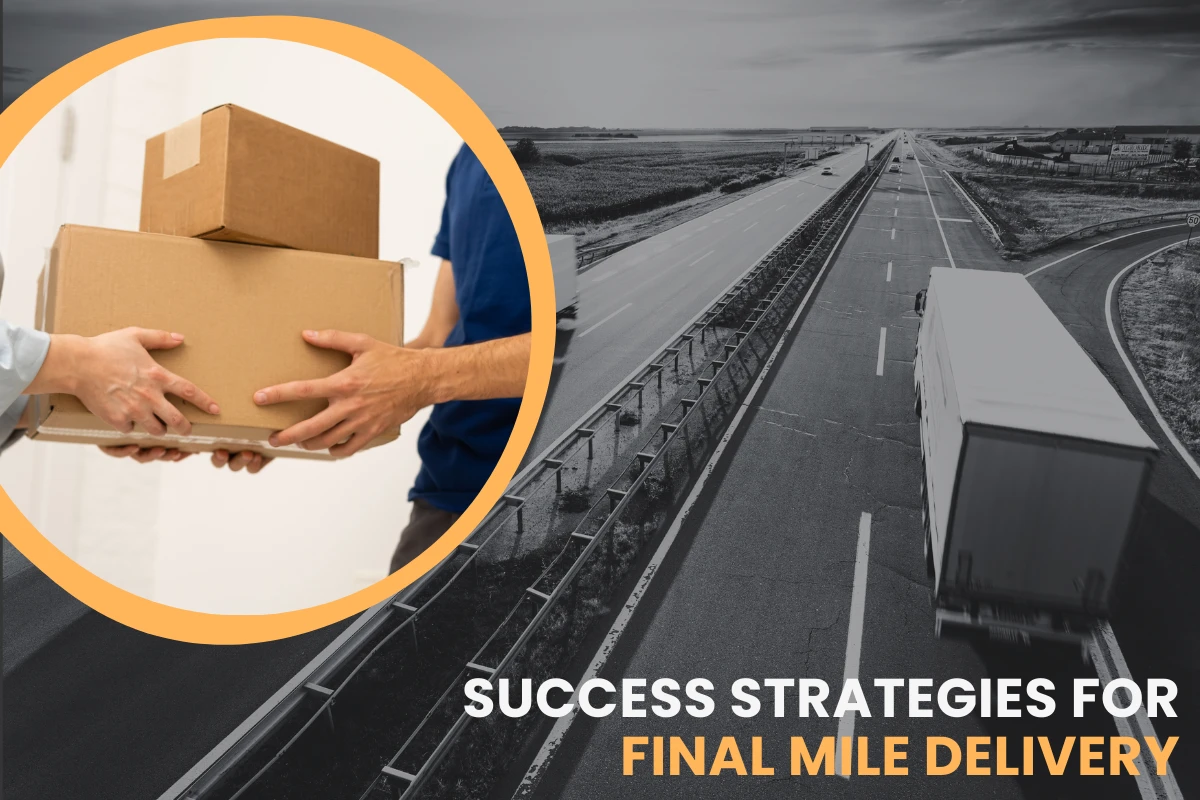
Logistics and fleet managers will tell you that the final leg of the delivery process is the costliest and most time-consuming part of the parcel’s journey and is sometimes fraught with problems. It’s also an essential part of the process from a customer satisfaction point of view and can have lasting repercussions on future relationships.
The steady growth in e-commerce in recent years has necessitated an increase in the efficient and timeous transportation of goods, creating an important niche in the economy for logistics and courier businesses.
There’s plenty of opportunity in this dynamic environment; however, it also means that existing logistics companies have to monitor their levels of competence and, in many cases, change their strategies to remain competitive.
Make 2024 the year of change for your business by embracing the latest technology that logistics technology has to offer.
Understanding final mile delivery
The term ‘final mile’ refers to the last step of the sales process, also known as the ‘last mile’ in some circles. The sale is secured, and the goods are packed and sent to the delivery hub. This is where the final mile begins: the parcel is entered into the logistics system, placed on a delivery truck, and transported to the customer.
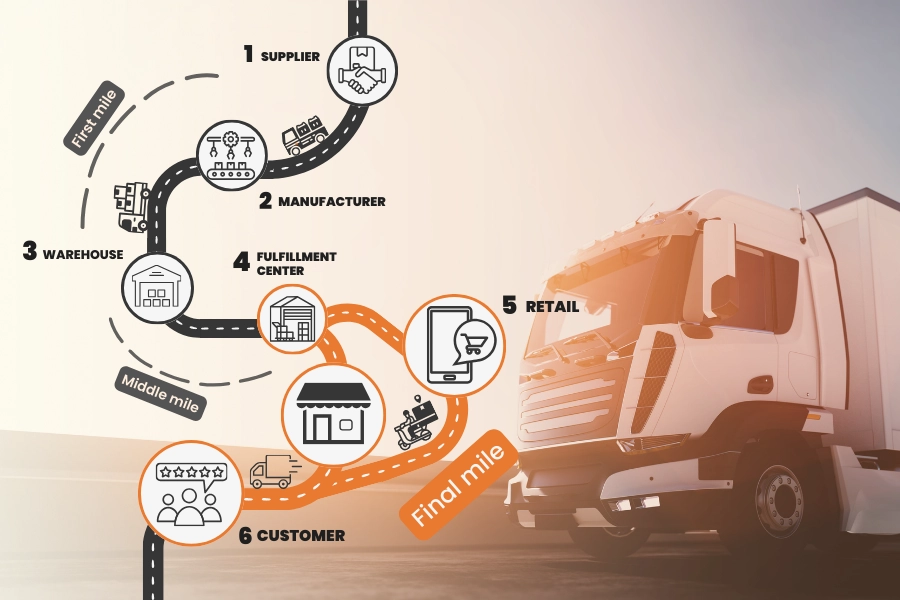
This may sound relatively straightforward, but the final mile delivery process certainly has its challenges. Incorrect goods or quantities, wrong addresses, unreachable customers, traffic jams, bad weather, and vehicle breakdowns easily disrupt a smooth process, wasting valuable time and affecting your costs and customer satisfaction levels.
Businesses that have already embraced the latest technology in this arena have an advantage over those still finding their way around. They present a more professional image to their customers and to the outside world as they employ the services of tech companies to assist with the use of data analytics and GPRS technology to plan and track their routes, improve communications, and optimize their operations to save both time and money.
The latest trends in final mile delivery
Logistics and fleet managers today know that proper planning is key to timely deliveries, and the constant improvements in technology mean having to keep informed about what is available and how it can improve their operations.
In these times of environmental challenges, operational efficiency is crucial for the sustainability of logistical operations. Saving fuel is the number one consideration in this regard, and this means planning your delivery schedule and routes so that your vehicles travel the shortest, most fuel-efficient routes.
When planning simple routes with, say, 10 stops, it’s a relatively simple task to determine start and end points, rest stops, one-way streets, etc. However, planning a multi-stop route with 20 stops or more becomes quite complicated, especially when you are spreading deliveries across more than one vehicle.
Tracking your vehicles once they have left your premises is just as important as planning the route. Monitoring mileage and fuel costs, the condition and performance of your vehicles, driver behavior, and conditions on the roads are all part of running a successful fleet of vehicles. Commercial cars today are fitted with sophisticated hardware and software to aid these tracking processes, and it’s worth knowing and understanding what you can utilize or install in the way of diagnostics.
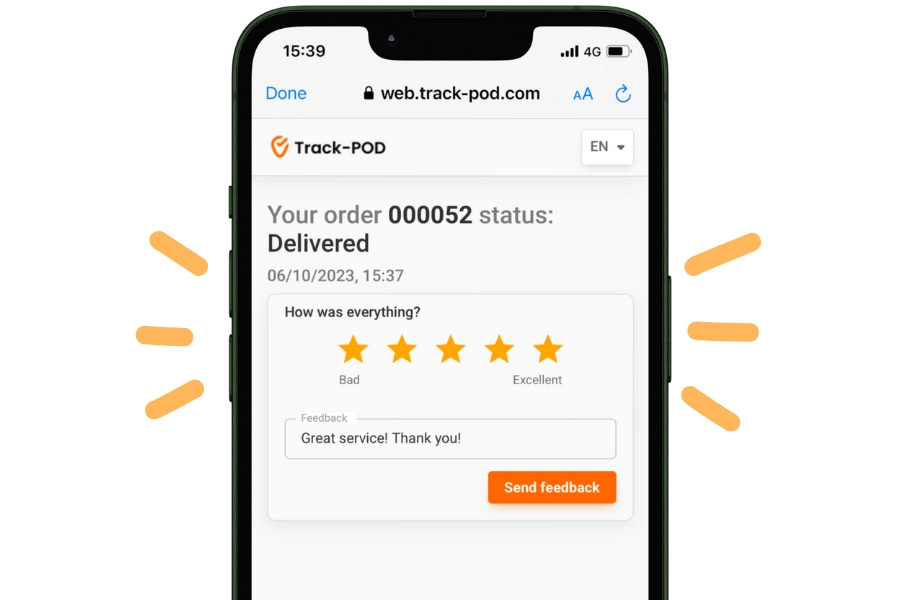
Another crucial consideration in the final mile process is customer satisfaction. Effective communications, timely deliveries, and a professional attitude will undeniably impress customers and secure further business deals. Technology today enables customers to track their deliveries in real-time with mobile phone apps, email notifications, and dashboard displays.
No-contact delivery options with customized documentation in electronic proof of delivery (ePOD) are also becoming popular with customers as they incorporate convenience and safety in the last-mile process.
There are a wealth of technology solutions out there that facilitate innovative delivery processes. Still, it’s a matter of finding the solution that suits your business, provided by a company that is likely to enhance its systems as technology improves, ensuring that you benefit from new innovations as they happen.
Technological innovations that are sure to enhance the final mile
Aside from the basic necessities in the way of route planners and vehicle tracking, how else can modern technology facilitate successful logistics operations within your business? We look at some innovative opportunities you may want to consider for optimising your final mile delivery processes.
The first step in the process is fitting various diagnostic devices to your truck’s engine, chassis, wheels, steering column, braking system, and more. Cameras on the dashboard or windscreen monitor the road ahead and what is happening in the truck's cab.
Once these are in place, a sophisticated communications network conveys data to a centralized hub that assimilates the data and stores it in the cloud. This network is facilitated by the Internet of Things (IoT), the interaction of devices that use the Internet as a communications medium, enabling global connectivity and communication between objects.
The stored diagnostic data includes information such as engine temperature, battery voltage, tire pressure, fuel levels, and so on. It also contains driver and truck safety information, such as bad driving habits and hard braking, seat belt use, and vehicle speed. Recording GPS points and times can identify routes taken and rest breaks.
Enter AI. Artificial intelligence is used to interrogate all of the diagnostic and tracking information that has been gathered, to monitor performance, and to notify drivers or management of potential problems with the vehicle, traffic snags up ahead, bad weather conditions, and more.
AI is on everyone’s lips today, and even as we try to understand the concepts, the learning process is improving and enhancing at unprecedented speeds. Here’s how AI is set to improve the logistics industry in the not-too-distant future:
Road safety
The installation of dashcams can have an impact on safety and compliance with traffic regulations. As a result of AI and machine learning, the dashcam software can recognize patterns and warn drivers of irregularities in the road, preventing bad outcomes and ultimately saving lives.
Likewise, electronic logging devices (ELDs) monitor drivers’ shift times and the way they drive and manage their vehicles. ELDs are mandatory in many countries and save lives as driver fatigue is minimized due to forced rest stops, and they become more aware of their conduct on the roads.
These devices do come at a cost; however, the data stored by the devices can prove or disprove claims arising out of incidents on the roads, and companies that install these devices can negotiate better deals with their insurance companies.
Weather apps driven by AI also promote safety on the road as they predict bad conditions and suggest alternative routes.
In cases of multiple routes and different drivers, historical data can be analyzed to determine whether routes to be undertaken are more suited to particular drivers. The findings may be based on personal experience and knowledge of specific routes; for example, some drivers are more comfortable on longer routes, while others may be better at dealing with certain demanding customers.
Autonomous trucks
As logistics companies wait in anticipation of introducing 100 percent driverless vehicles to the industry, truck manufacturers have begun incorporating various autonomous capabilities into the newer models. In the opinion of Bryan Jones of CCJ:
One of the hurdles facing the adoption of autonomous trucks for long-haul usage will be the regulatory requirements, and this is set to take some time.
Autonomous trucks' benefits include eliminating driver fatigue, distractions, and human fatigue. Anticipated cost savings should be evident in reducing road accidents, thus cheaper insurance policies, efficient driving resulting in fuel savings, and eliminating drivers’ wages. AI-powered trucks could drive more extended hours, avoiding congestion at peak times.
Currently, cameras mounted on the windscreen can focus on the inside of the cab and on the road, even detecting when the driver is using a cell phone and issuing a suitable alert.
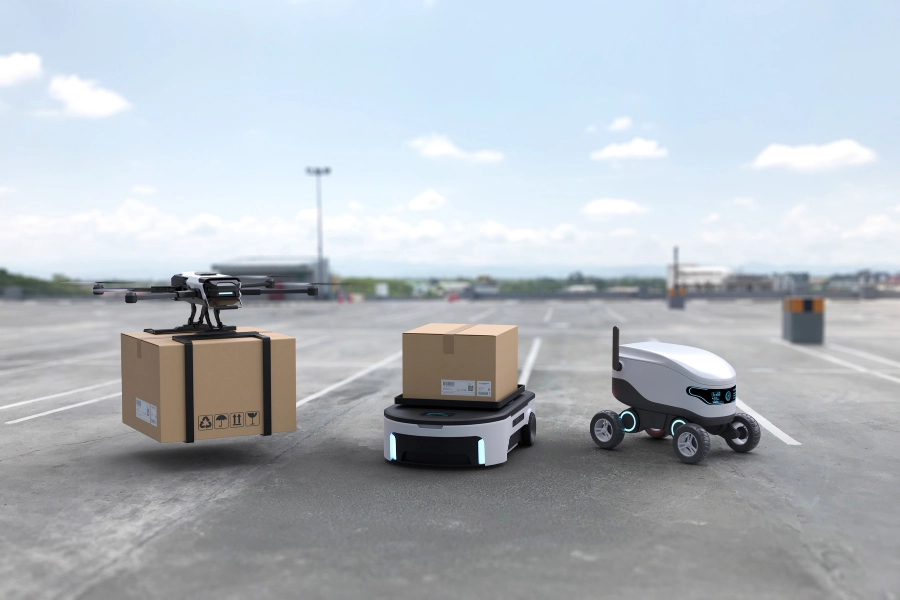
Driver coaching software is also available for trucks, powered by AI, that can detect issues and convey information to the head office regarding speeding and violations such as not stopping at red lights or stop streets.
In an interview with Fox Business, the director of Good Greek Moving and Storage in Florida reports that AI software alerts them if a truck driver is on the phone or texting or if they are smoking in the cab, contravening the company’s policy. He reports that insurance claims have been reduced as AI records everything that happens before, during, and after an accident. Insurance is able to determine the cause of the accident by analyzing the evidence stored on various AI devices.
Of course, all of this would not be possible if it were not for the communications between the various devices within the truck and external computer hardware and networks. This is made possible by the Internet of Things (IoT), a network of devices that talk to one another, sending signals, helping drivers navigate by communicating with external mapping technology, and maintaining communications between the diagnostic devices and sensors placed within truck engines and components so that AI can identify any problems and prompt drivers and managers to deal with them.
Drones
We’ve come a long way since the introduction of drones. The latest drones can now lift substantial weights, fly long distances, and execute precision drop-offs in adverse weather conditions. Drones have many uses and are ideal for transporting products to remote locations with limited access or for delivering emergency supplies where traffic conditions are prohibitive. In these situations, drones offer safety, speed, and efficiency.
Commercial drones can carry up to 30 kg within a 16 km range and can travel up to 20 meters per second. They can reach high altitudes of about 6,000 square meters and handle temperatures between -20 degrees and 45 degrees Celsius.
Two delivery systems include a winch mode for aerial drop-offs or cargo mode with a designated cargo area that secures the parcel for a safe landing. Depending on the customer's requirements, you can use both methods in your logistics business. Both winch and cargo modes are ideal for no-contact delivery options.
Winch mode is used when the customer provides exact coordinates for the drop-off of the parcel, usually in locations that are difficult to access, such as building sites in awkward places, mountain dwellings, or ship decks. The parcel is lowered into position, and cameras on the drone photograph the parcel in its location as proof of delivery. Alternatively, if you’re using cargo mode, the drone will land, and the cargo hold will be opened by someone on the receiving side who will remove the parcel.
Success stories in final mile delivery
Logistics and fleet managers, courier companies, and small businesses all attest to saving time and money by implementing route planning and vehicle tracking functionality in their companies.
Truck and trailer experts in Europe, Skuba, promise their customers a two-hour delivery period after receipt of the order. Before installing routing and tracking software, Skuba used customer delivery addresses to plan their routes and distribute the deliveries between their drivers. However, they had no idea how many deliveries a driver could do in a day and could not give customers reliable delivery times.
The Track-POD route planning software that Skuba installed uses GPS technology instead of physical addresses for more accurate routes. They can give their customers an exact ETA provided by an AI-assisted application that uses GPS coordinates to calculate the distances between drop-off points and to anticipate other factors such as poor weather conditions, roadworks, and traffic jams.
The Skuba team is happy with the optimization of their delivery processes, stating that due to the visibility of their operational data, they can plan the number of drivers needed and provide their customers with accurate information regarding the progress of their delivery. Their orders have doubled, while the vehicle and staff numbers have remained unchanged.
Another success story is Tyreline Distributors Limited, based in New Zealand. Due to vehicle and driver shortages, Tyreline struggled with tracking outsourced deliveries and reporting to their customers. Since the implementation of Track-POD’s final mile delivery methods, Tyreline customers have been able to track their deliveries, which has built up trust in customer relationships. Tyreline has also managed to organize its business and delivery processes to the point that it can plan its deliveries a couple of days ahead and know its drivers’ movements in advance.
The success of the two companies mentioned above can be attributed to successful route planning and customer satisfaction. The final mile logistics software offers a complete package that facilitates the last leg of the journey for your clients’ packages, giving them the tools to track their deliveries and communicate with the driver and dispatch personnel.
Track-POD’s vehicle tracking system communicates with the various diagnostics in your vehicles, predicting vehicle maintenance issues, identifying the area of the problems, and suggesting timely repairs.
The Track-POD system tracks the parcel from the time it is entered into the logistics system, through loading onto the vehicle, until it reaches its destination, and much in between.
The aim is not just to get the parcel to the client using the most efficient route, safely and on time, but also to provide the customer with a transparent and interactive experience as they track their parcel and intervene if something unexpected crops up. Customers can request a no-contact delivery and specify a safe drop-off point. Drivers and customers are in touch throughout the process until the driver finally drops the parcel off and takes a photograph as proof of delivery. This e-POD is sent directly to the customer and saved in a database for further retrieval.
If you are still using a manual system to schedule deliveries and manage your drivers, here are some reasons why you should consider upgrading to a computerized system:
- The system can plan your routes using GPS technology and AI intuition, allocating the most suitable driver to an efficient delivery schedule.
- Let your customers know exactly when to expect their delivery based on GPS technology and accurate calculations of all ETAs along the route.
- Drivers can no longer take extended stops in unscheduled locations as your tracking device and AI-enabled diagnostics trace their every move.
- The installation of electronic logging devices records shift times, including idle time, rest times, and the total number of hours worked, relieving drivers of the need to perform hours of administrative work.
Looking ahead: the future of final mile delivery
Final mile delivery is a concept that is catching on as more and more businesses realize that inefficient delivery processes come with a high cost, both in terms of money and resources. Streamlining your logistics operations saves time, manpower, and vehicles and is conducive to good customer relations.
As can be seen from the above, with the extensive use of GPS technology, together with vehicle diagnostics, IoT communications, and the intuitive assistance of AI, trucking is now a guessing game that is fraught with problems. By embracing technology in your business, you maximize the efficiency of your operations while reducing the risks to drivers, vehicles, and cargo.
The science of logistics is constantly changing, and this trend is set to continue. The testing of autonomous vehicles is already underway and will hopefully become a reality for long-distance driving within the next few years. Drones are an eco-friendly alternative for companies with depots in outlying areas, with little air traffic and a need for speedy deliveries. In urban areas, drones can be used for fast, lightweight deliveries; however, there are still some regulatory hurdles to be overcome.
In these environmental issues, sustainable logistics in the form of electric vehicles and drones are gaining popularity fast, and we should see some improvements in this area.
Conclusion
To stay ahead in the business of transporting goods, you need to remain competitive and avoid becoming complacent.
- Keep track of your costs to save money and plow it back into your business.
- Maintain your vehicles regularly to improve fuel efficiency and prolong their lives.
- Plan your delivery routes, reduce travel distances, and improve delivery times.
- Invest in technology designed by professionals and software that is likely to be upgraded as new technologies appear on the logistics horizon.
It is your selection of the right technology that will make the difference to your operations, with efficiency and cost being top priorities when it comes to making decisions about logistics systems and what they can do for you.


